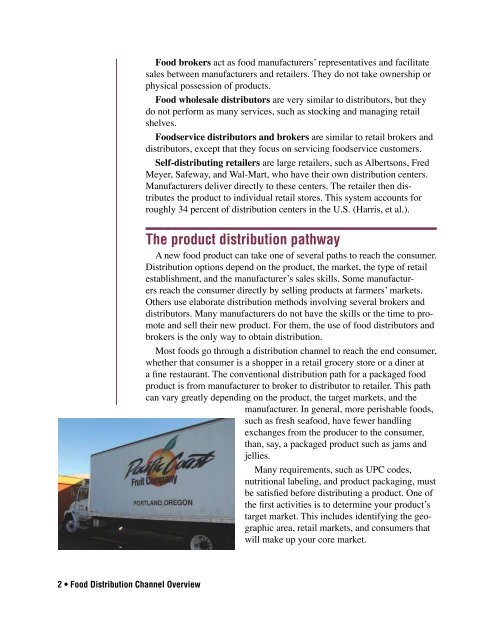Food Distribution Channel Overview - ScholarsArchive at Oregon ...
Food Distribution Channel Overview - ScholarsArchive at Oregon ...
Food Distribution Channel Overview - ScholarsArchive at Oregon ...
You also want an ePaper? Increase the reach of your titles
YUMPU automatically turns print PDFs into web optimized ePapers that Google loves.
2 • <strong>Food</strong> <strong>Distribution</strong> <strong>Channel</strong> <strong>Overview</strong><br />
<strong>Food</strong> brokers act as food manufacturers’ represent<strong>at</strong>ives and facilit<strong>at</strong>e<br />
sales between manufacturers and retailers. They do not take ownership or<br />
physical possession of products.<br />
<strong>Food</strong> wholesale distributors are very similar to distributors, but they<br />
do not perform as many services, such as stocking and managing retail<br />
shelves.<br />
<strong>Food</strong>service distributors and brokers are similar to retail brokers and<br />
distributors, except th<strong>at</strong> they focus on servicing foodservice customers.<br />
Self-distributing retailers are large retailers, such as Albertsons, Fred<br />
Meyer, Safeway, and Wal-Mart, who have their own distribution centers.<br />
Manufacturers deliver directly to these centers. The retailer then distributes<br />
the product to individual retail stores. This system accounts for<br />
roughly 34 percent of distribution centers in the U.S. (Harris, et al.).<br />
The product distribution p<strong>at</strong>hway<br />
A new food product can take one of several p<strong>at</strong>hs to reach the consumer.<br />
<strong>Distribution</strong> options depend on the product, the market, the type of retail<br />
establishment, and the manufacturer’s sales skills. Some manufacturers<br />
reach the consumer directly by selling products <strong>at</strong> farmers’ markets.<br />
Others use elabor<strong>at</strong>e distribution methods involving several brokers and<br />
distributors. Many manufacturers do not have the skills or the time to promote<br />
and sell their new product. For them, the use of food distributors and<br />
brokers is the only way to obtain distribution.<br />
Most foods go through a distribution channel to reach the end consumer,<br />
whether th<strong>at</strong> consumer is a shopper in a retail grocery store or a diner <strong>at</strong><br />
a fine restaurant. The conventional distribution p<strong>at</strong>h for a packaged food<br />
product is from manufacturer to broker to distributor to retailer. This p<strong>at</strong>h<br />
can vary gre<strong>at</strong>ly depending on the product, the target markets, and the<br />
manufacturer. In general, more perishable foods,<br />
such as fresh seafood, have fewer handling<br />
exchanges from the producer to the consumer,<br />
than, say, a packaged product such as jams and<br />
jellies.<br />
Many requirements, such as UPC codes,<br />
nutritional labeling, and product packaging, must<br />
be s<strong>at</strong>isfied before distributing a product. One of<br />
the first activities is to determine your product’s<br />
target market. This includes identifying the geographic<br />
area, retail markets, and consumers th<strong>at</strong><br />
will make up your core market.















